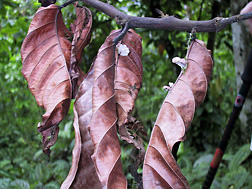Genetic Resistance to Cacao Diseases
Is Key to Safeguarding Chocolate Production
In recent years, the cocoa industry has been threatened by a trio of devastating fungal diseases—frosty pod, black pod, and witches’ broom. The diseases afflict Theobroma cacao trees, the beans of which are the source of cocoa, cocoa butter, and chocolate.
To help stave off further damage to cacao cultivation, researchers at ARS’s Subtropical Horticulture Research Station (SHRS) in Miami, Florida, are using molecular genetic techniques to speed development of new disease-resistant and productive T. cacao cultivars.
Witches’ broom, Moniliophthora perniciosa, and frosty pod, M. roreri, are found in South America. Witches’ broom causes the growing parts of cacao trees to become swollen and branched, while frosty pod attacks the developing seed pods.
Neither disease has appeared so far in Africa or Asia, where cacao is also grown. Such spread would have devastating consequences for the chocolate industry. Keeping M. roreri out of Africa was one of the main objectives of the cacao genetics project in Miami, which included a special emphasis on establishing Moniliophthora-resistant material in clonal gardens in West Africa.
Black pod is caused by several different species of Phytophthora, which forms a chocolate-brown lesion on the pod surface. It is the most important cacao disease worldwide. One species, P. megakarya, is very destructive in Africa. Its spread throughout the West African growing area, which produces 60 percent of the beans for the global market, is causing major losses.
In 1999, SHRS scientists initiated a project with M&M Mars, Inc., one of the largest worldwide manufacturers of chocolate products. The team, led by plant geneticist Ray Schnell, has since produced genetic linkage maps from cacao populations segregating for resistance to frosty pod, black pod, and witches’ broom as well as other horticultural traits.
“These genetic linkage maps can be equated to road maps, with stretches of DNA called ‘markers’ acting as signposts along each chromosome of the cacao genome,” says Schnell.
Schnell and fellow SHRS plant geneticists Steve Brown, David Kuhn, and Cecile Tondo, along with Mars and international cooperators (see box), have developed a marker-assisted selection (MAS) program for breeders. They are interested in markers known as “quantitative trait loci,” or QTLs, that are closely linked to the genes that underlie a trait in question.
QTLs have been identified for resistance to witches’ broom, frosty pod, and black pod and have allowed development of new productive and disease-resistant cultivars of cacao through MAS. These new selections are currently being distributed to farmers in Central and South America.
Five QTLs for frosty pod resistance were found, and these advantageous genes are being used for scoring progeny—or evaluating seedlings—in ongoing cooperative MAS projects.
Three QTLs for black pod resistance were found, as well as one QTL each for average trunk diameter growth and pod color.
Another population from Brazil has yielded two QTLs for resistance to witches’ broom. These have also been found along with QTLs for other desirable phenotypic traits.
“MAS increases the efficiency of selection for disease resistance and other traits by enabling undesirable progeny to be eliminated early in the selection process,” says Schnell. “This saves a considerable amount of time and money in field evaluation of new varieties.”—By Alfredo Flores, Agricultural Research Service Information Staff.
This research is part of Plant Genetic Resources, Genomics, and Genetic Improvement, an ARS national program (#301) described on the World Wide Web at www.nps.ars.usda.gov.
Raymond J. Schnell is with the USDA-ARS Subtropical Horticulture Research Station, Subtropical Horticulture Research Unit, 13601 Old Cutler Rd., Miami, FL 33158; phone (786) 573-7074, fax (786) 573-7102.
Cooperation Speeds Success
In their molecular-genetics research on cacao breeding, scientists at the Agricultural Research Service’s Subtropical Horticulture Research Station collaborated with scientists at Centro Agronómico Tropical de Investigación y Enseñanza, in Costa Rica; the Instituto Nacional Autunomo de Investigaciones Agropecuaris, in Ecuador; and the Comissão Executiva do Plano da Lavoura Cacaueira, in Brazil.
Several African organizations have been vital to the success of the black pod resistance research: In Cameroon, the Institute of Agricultural Research for Development and the French Agricultural Research Center for International Development; the Cocoa Research Institute of Ghana; the Cocoa Research Institute of Nigeria; and the International Institute of Tropical Agriculture in Ibadan, Nigeria.
"Genetic Resistance to Cacao Diseases Is Key to Safeguarding Chocolate Production" was published in the September 2008 issue of Agricultural Research magazine.







